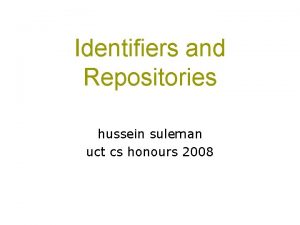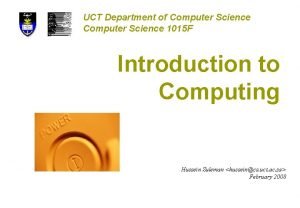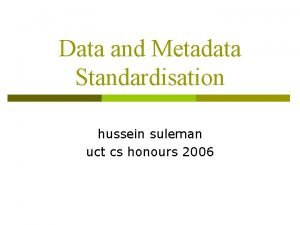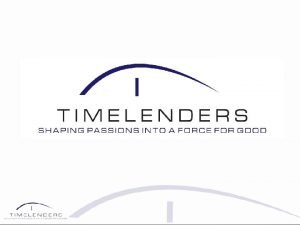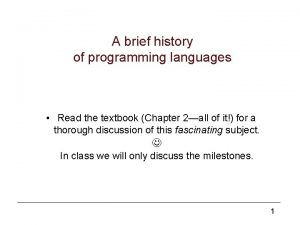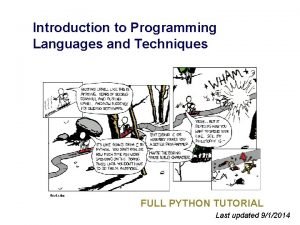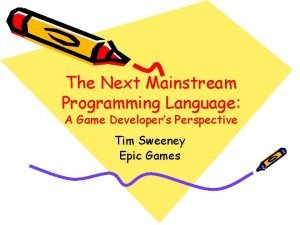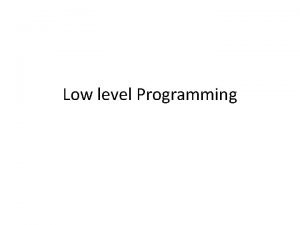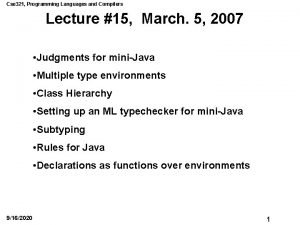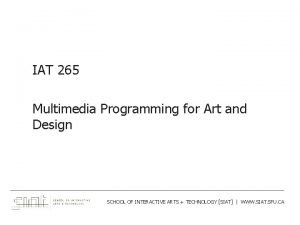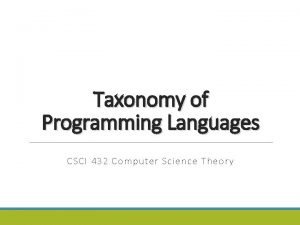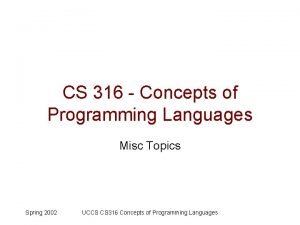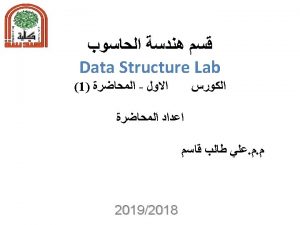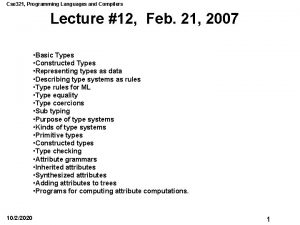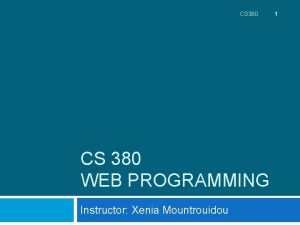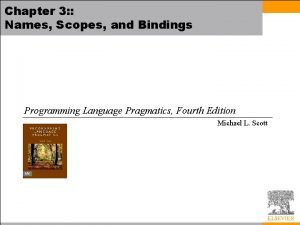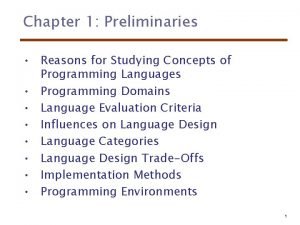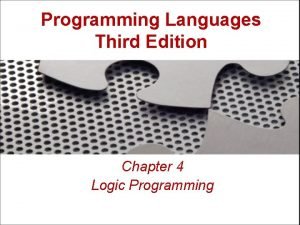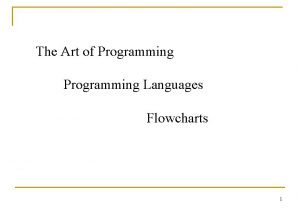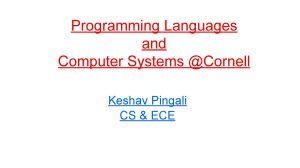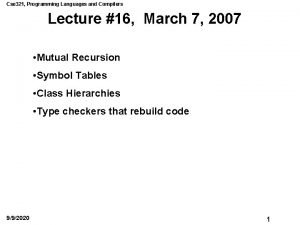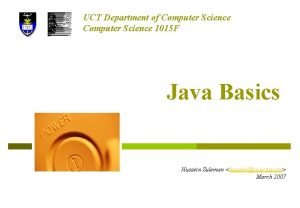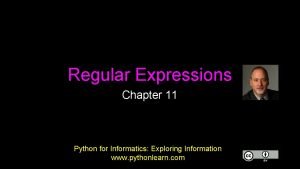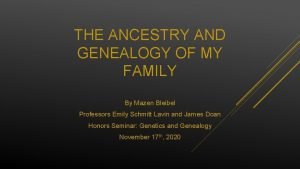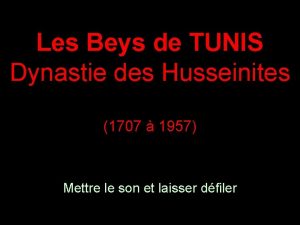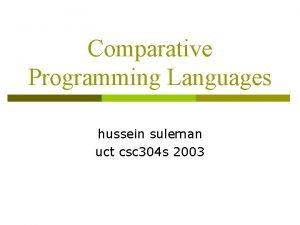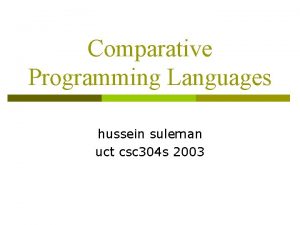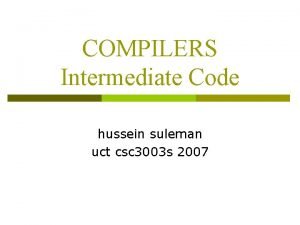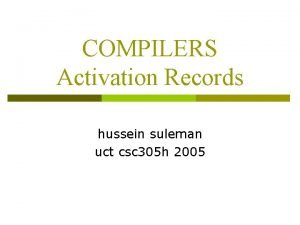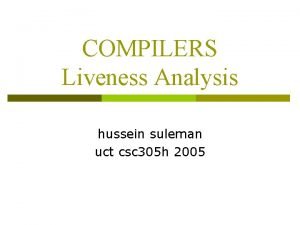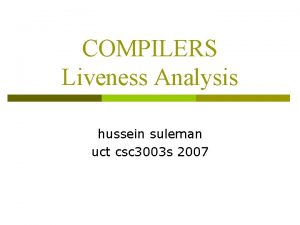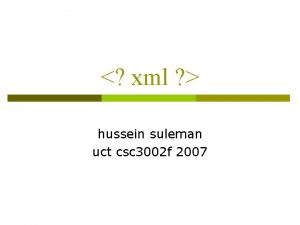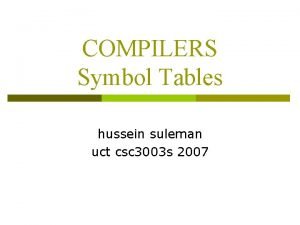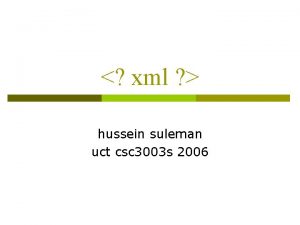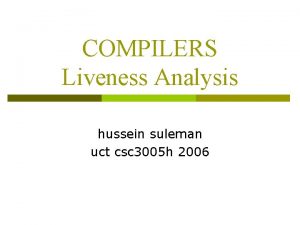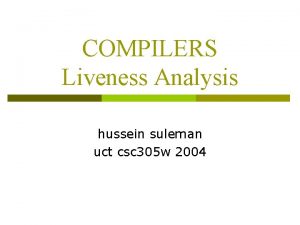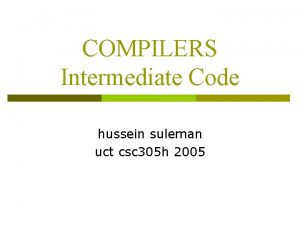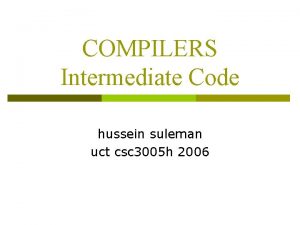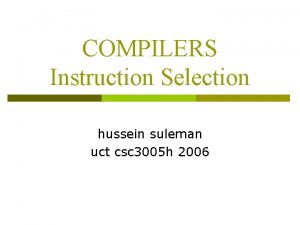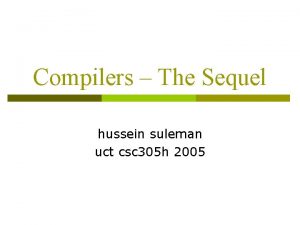Comparative Programming Languages hussein suleman uct csc 304




































































- Slides: 68

Comparative Programming Languages hussein suleman uct csc 304 s 2003

Course Structure 15 lectures p 2 assignments p n n p 1 x 2 -week programming assignment 1 x 1 -week “written” tutorial open-book final (1/2 paper)

Course Topics p p p overview of paradigms evolution of languages assignment and expressions types, variables, binding and scope pointers and memory management control structures, subprograms runtime execution exceptions concurrency visual languages scripting languages

Overview of Paradigms and PL Issues

Why study programming languages? Understand differences and similarities. p Understand concepts and structures independently of languages. p Learn reasons for design decisions in particular languages. p Develop the ability to choose appropriate languages and paradigms for particular tasks. p Develop the ability to design languages. p

Common paradigms paradigm n. pattern, model - Dorling Kindersley Dictionary p Procedural n a. k. a. Imperative p imperative = peremptory, urgent, necessary § peremptory = imperious, dictatorial, precluding opposition § imperious = dominating, dictatorial Object-oriented p Declarative p n p a. k. a. Logic Functional

Examples Language C C++ Java Clean Prolog Assembly Language Visual C++ HTML C# Javascript Paradigm

(Programming) Languages are used to standardise communication. p What makes it a programming language? p Is HTML a programming language? Javascript? SQL? p 3 traditional concepts: p n n n sequence selection iteration

Issues in comparing languages Simplicity p Orthogonality p Control structures p Data types and type checking p Syntax p Abstractions p Exceptions p Aliasing p

Issue: Simplicity Languages that are complex to read and write are less likely to be understood by a large group of individuals equally well. p Many different ways of expressing the same construct may be easier for writing but not for reading/translating. p n p Examples: if (a<b) { c=d } else { c=e }; c = a<b? d: e c = e; c=d if (a<b); Is simplicity always good?

Issue: Orthogonality Does the same set of rules apply to all constructs and data structures? p If it seems reasonable that a feature should work, does it? p Mathematical perspective: p n n p Orthogonal vectors can form the basis for a vector space. (0, 1) and (1, 0) are orthogonal vectors so every 2 -element vector (x, y) can be expressed as “a(0, 1)+b(1, 0)”. Similarly orthogonal language features allow all possible combinations / programs. Is orthogonality always good?

Issue: Control Structures Transfer control within a program to effect variable behaviour. p Supports selection and iteration within languages. p “goto considered harmful” p n p How does the inclusion of goto affect the ability of programmers to read, write and maintain code? Dijkstra and structured programming

Issue: Data Types and Checking Supply appropriate types and type mechanisms that are meaningful and selfregulating. p Example: p n Enumerations restrict values to a small predefined set while implicit enumerations using an integer do not benefit from strong typing. More complex data structures make it easier to understand the logic. p Run-time vs. compile-time type checking p n Mathematica has to type-check at runtime, therefore less efficient!

Issue: Syntax Complexity of syntax makes languages more difficult to learn/understand. p “Arbitrary” restrictions, like identifier formats, have to be learnt. p The same symbols/keywords with multiple meanings dependent on context decreases readability of code. p n Examples: “=” for equality testing and assignment in Pascal. p “=0” for pure virtual functions and assignment in C++. p

Issue: Expressivity p Program writability is supported by concise syntax to express general and complex functions. n Example: p Perl regular expressions can perform widely varying functions with single lines of code: § s/(? <!wo)man/woman/go replaces all man with woman § s/([^ ]+) (. *)/$2 $1/go moves first word to last § /[a-z. A-Z_][a-z. A-Z 0 -9_]*/ checks for valid identifiers p Is expressivity good for maintenance?

Issue: Abstractions p Data abstractions hide the details of complex data structures. n Example: p p Process abstraction hides the details of complex algorithms and processes. n Example: p p The C++ Standard Template Library Python modules Object-oriented programming supports both approaches!

Issue: Exceptions are special circumstances that must be handled in a non-standard manner in programs. p Exceptions must be handled immediately or promoted to a higher level of abstraction. p n Example: try { … } catch (Exception e) { … } p Why do we use exceptions?

Issue: Aliasing Multiple names for a single memory location. p Aliases break the 1 -to-1 correspondence between variables and storage locations, therefore affecting readability. p Pointer-based data structures with aliases affect memory management strategies. p Union data types circumvent strong typechecking. p

Machine architecture effects von Neumann computers are best suited for imperative languages. p Object-oriented languages are an abstraction over imperative languages. p Functional languages are frequently interpreted or compiled along with dynamic type-checking code to fit the imperative model. p Declarative languages rely on an inference engine to execute the “programs”. p

Execution models p Compilation n Program converted to native machine code and executed directly on processor. p p Interpretation n Program understood and logic acted upon by interpreter. p p e. g. , Visual C++ e. g. , Prolog Hybrid n Program converted to intermediate representation, which is “executed” in virtual machine. p e. g. , C#

Evolution of Languages

Plankalkül Example | V | K | S | X + 1 => Y 0 0 2 1 1. n Equivalent Java: Y 0[1] = X 0[2] + 1

Plankalkül Etymology Who? Plan = Plan kalkül = Calculus Plankalkül = Programming calculus Konrad Zuse When? 1945 Why? To express computations in data processing Interesting Features Primitive support for matrices/indices, assertions Notes Way before its time!

Fortran Example i = 1 10 if (i. le. 100) then i = 2*i write (*, *) i goto 10 endif if (j-2) 20, 30, 40 40 goto (50, 60) j-2

Fortran Etymology FORmula TRANslating system Who? John Backus (et al) @ IBM When? 1956 (I), 1958 (II), 1962 (VI), 1978 (77), 1992 (90) Why? Scientific computation – availability of IBM 704 machine Interesting Features Implicit typing based on name of variable, independent compilation (II), arithmetic IF, computed GOTO Notes First compiled high-level language!

LISP Example ; ; ; ; ; Simple towers of Hanoi program. Note that Start-Peg and Goal-Peg are integers from 1 to 3 indicating the peg number. Ie to move 4 discs, starting on the first peg and finishing on the last one, execute (Towers 4 1 3) 1992 Marty Hall. hall@aplcenmp. apl. jhu. edu (defun Towers (Number-of-Discs Start-Peg Goal-Peg) (cond ((= 1 Number-of-Discs) (format t "~%Move Top Disc from peg ~D to peg ~D. " Start-Peg Goal-Peg)) (t (Towers (1 - Number-of-Discs) Start-Peg (Remaining-Peg Start-Peg Goal-Peg)) (Towers 1 Start-Peg Goal-Peg) (Towers (1 - Number-of-Discs) (Remaining-Peg Start-Peg Goal-Peg)))) ; ; ; ===================================== ; ; ; Given two peg numbers, what is the peg number of the third peg? (defun Remaining-Peg (Peg 1 Peg 2) (- 6 Peg 1 Peg 2))

LISP Etymology LISt Processing Who? John Mc. Carthy (et al) @ MIT When? 1959, 1984 (Common LISP) Why? Interesting Features To support symbolic computation using mathematical functions and conditional expressions Simple and orthogonal syntax, recursion, dynamic type binding Notes Pioneer functional language

ALGOL Example // the main program (this is a comment) // Program from http: //www. engin. umd. umich. edu/CIS/course. des/cis 400/algol/average. html begin integer N; Read Int(N); begin real array Data[1: N]; real sum, avg; integer i; sum: =0; for i: =1 step 1 until N do begin real val; Read Real(val); Data[i]: =if val<0 then -val else val end; for i: =1 step 1 until N do sum: =sum + Data[i]; avg: =sum/N; Print Real(avg) end

ALGOL Etymology ALGOrithmic Language Who? GAMM / ACM – transatlantic group of representatives When? 1958, 1960, 1968 Why? To create a universal language Ancestry FORTRAN I Interesting Features Block structure / compound statements, BNF (60), Dynamic arrays, Call-by-name, Orthogonality in data types (68) Machine-independent, formally specified Notes

COBOL Example $ SET SOURCEFORMAT"FREE" IDENTIFICATION DIVISION. PROGRAM-ID. Multiplier. AUTHOR. Michael Coughlan. * Example program using ACCEPT, DISPLAY and MULTIPLY to * get two single digit numbers from the user and multiply them together DATA DIVISION. WORKING-STORAGE SECTION. 01 Num 1 01 Num 2 01 Result PIC 9 VALUE ZEROS. PIC 99 VALUE ZEROS. PROCEDURE DIVISION. DISPLAY "Enter first number (1 digit) : " WITH NO ADVANCING. ACCEPT Num 1. DISPLAY "Enter second number (1 digit) : " WITH NO ADVANCING. ACCEPT Num 2. MULTIPLY Num 1 BY Num 2 GIVING Result. DISPLAY "Result is = ", Result. STOP RUN.

COBOL Etymology COmmon Business Oriented Language Who? US Department of Defence When? 1960, 1968/74/85 (ANSI) Why? Easy to use, more English than scientific, broaden base of programmers Interesting Features Macros, hierarchical data structures, program divisions Evaluation Widespread use in business computing, especially electronic accounting

BASIC Example 10 REM Very simple GW-BASIC program 20 REM 30 PRINT “How many students are in CSC 304? “ 40 INPUT N 50 FOR I=1 to N 60 GOSUB 90 70 NEXT I 80 GOTO 30 90 PRINT “Student number: “; I 100 PRINT “Enter a name” 110 INPUT NAME$ 100 RETURN

BASIC Etymology Beginners All-purpose Symbolic Instruction Code (controversial) Who? Dartmouth University When? 1964 Why? Pleasant and friendly language for non-scientists Ancestry ALGOL 60, FORTRAN IV Interesting Features Timeshared computers and microcomputers Notes Poor structure but easy to learn, evolved into current-day Visual BASIC

PL/I Etymology Who? Programming Language One IBM When? 1965 Why? Combine best parts of FORTRAN, COBOL, ALGOL to create universal language Ancestry ALGOL 60, FORTRAN IV, COBOL Interesting Features Concurrency, pointers, matrix slicing Notes Very complex due to support of large number of (low-level) features

SIMULA Etymology Derived from “simulation” Who? Nygaard and Dahl When? 1964 (v 1), 1967 (SIMULA 67) Why? System simulation where routines can restart at previously stopped positions Ancestry ALGOL 60 Interesting Features Classes Notes Forerunner of modern objectoriented languages

PASCAL Example program test; var i, j : integer; function square ( s : integer ) : integer; var t : integer; begin t : = s*s; return t; end; begin Writeln (‘Test program for UCT-CPL’); Readln (i); j : = square (i); Writeln (i, ‘ squared is ’, j); end.

Pascal Etymology Named after Blaise Pascal Who? Niklaus Wirth When? 1971 Why? Simpler derivative from ALGOL 60 (than ALGOL 68) Ancestry ALGOL W / ALGOL 60 Interesting Features Notes Designed and widely used for teaching Computer Science

C Etymology CPL B C Who? Kernighan and Ritchie When? 1971 Why? Systems programming Ancestry ALGOL 68, B Interesting Features Complete lack of type checking! Notes Part of UNIX OS

Modula 2, Modula 3, Oberon Etymology Probably something to do with modules Who? Wirth, DEC/Olivetti, Wirth When? 1976, 1989, 1993 Why? Ancestry Evolution of Pascal to include modular programming (Modula-2), objection orientation (Modula-3, Oberon) Pascal Interesting Features Oberon is designed to be simpler than Modula-2! Notes

Prolog Etymology PROgramming LOGic Who? Colmerauer, Roussel, Kowalski When? 1975 Why? To specify programs in formal logic notation – viz. predicate calculus Interesting Features Based on a fact/rule database and inferencing Notes Only applicable to few domains and code is not very efficient on regular computers

Ada Example with Stack_Int; use Stack_Int; procedure Demo_GS is -- Demonstrate the use of the Generic_Stack package by using a -- Stack of Integers. -- from ADA 95 Lovelace Tutorial, David A. Wheeler Stack 1, Stack 2 : Stack; Dummy : Integer; begin Push(Stack 1, 1); -- Put 1 onto Stack 1. Push(Stack 1, 2); -- Put 2 onto the Stack 1. Stack 2 : = Stack 1; -- Copy stack 1's contents into stack 2. Pop(Stack 2, Dummy); -- Dummy is now 1. -- Now Stack 2 is empty and Stack 1 has two items. end Demo_GS;

Ada Etymology Named after Augusta Ada Byron Who? US Department of Defence When? 1983, 1995 Why? To standardise a programming language for all the Do. D’s operations and embedded systems Pascal Ancestry Interesting Features Notes Generic program units, concurrency

Smalltalk Etymology Who? Alan Kay When? 1969, 1972, 1980 Why? To support highly interactive object -oriented desktop paradigm Ancestry SIMULA 67 Interesting Features Objects invoking methods by exchanging messages Notes Promoted WIMP methodology

C++ Etymology Who? Probably the one after “C” in C++ syntax Ellis and Stroustrup When? 1986, 1990 Why? Make C object-oriented Ancestry C and SIMULA 67 Interesting Features Plain C + object-orientation Notes

PERL Example # Get CGI parameters and convert to hash # for a Web form processing application $_=$ENV{'QUERY_STRING'}; @parray=split (/[=&]/); foreach (@parray) { s/+/ /g; s/n//g; s/%[0 -9 A-F]/sprintf("%c", hex (substr ($&, 1)))/ge; while (substr ($_, 0, 1) eq ' ') { $_ = substr ($_, 1); } while (substr ($_, length ($_)-1, 1) eq ' ') { chop $_; } $_ = lc ($_); } %qarray=@parray;

PERL Etymology Practical Extraction and Report Language Who? Larry Wall (et al) When? 1987 Why? Simple text processing and systemlevel scripting Interesting Features Regular expressions Notes Simple to write but difficult to read/modify

Mathematica Example (* Bisection algorithm to find a given *) (* value in an ordered list *) Search[x_, values_] : = Module[{Mid, Start=1, Stop=Length[values]}, While[Start+1 != Stop, Mid = Floor[(Start+Stop)/2]; If[values[[Mid]] > x, Stop=Mid, Start=Mid ] ]; Start ]

Mathematica Etymology Related to mathematics Who? Wolfram Research Institute When? 1988 Why? To support advanced mathematical calculations Interesting Features Functional and imperative programming Notes Tree structured programs and data (LISP-like)

Python Example # example from www. python. org # function to invert a table def invert(table): index = {} # empty dictionary for key in table. keys(): value = table[key] if not index. has_key(value): index[value] = [] # empty list index[value]. append(key) return index

Python Etymology From “Monty Python’s Flying Circus” Who? CWI, CNRI When? 1990 Why? Extensible object-oriented scripting language Interesting Features Indentations for block structure Notes

Java Etymology Who? SUN Microsystems When? 1995 Why? For reliability in program consumer devices Ancestry C++ Interesting Features Embeddable in Web pages, no pointers – only references, single inheritance, garbage collection Notes No direct compilation – use of intermediate bytecode

PHP Example <!-- from J. Fulton, PHP Tutorial --> <h 2>Simple Form Example</h 2> <? function show_form($first="", $last="") { ? > <form action="simple. Form. php 3" method="post"> First Name: <input type=text name=first value="<? echo $first? >"> Last Name: <input type=text name=last value="<? echo $last? >"> <input type=submit> </form> <? } if(!isset($first)) { show_form(); } else { if(empty($first) or empty($last)) { echo "You did not fill in all the fields, try again<p>"; show_form($first, $last); } else { echo "Thank you, $first $last"; } } ? >

PHP Etymology PHP Hypertext Processor Who? Rasmus Lerdorf (et al) When? 1994 Why? Embedded scripting language for Web pages Ancestry C, Java, Perl Interesting Features Persistent and shared state between invocations Notes

XSLT Example <stylesheet> <output method="xml"/> <variable name="institution"><text>UCT</text></variable> <template match="uct: uct"> <oaidc: dc> <dc: title><value-of select="uct: title"/></dc: title> <apply-templates select="uct: author"/> <element name="dc: publisher"> <value-of select="$institution"/> </element> <apply-templates select="uct: version"/> </oaidc: dc> </template> <template match="uct: author"> <dc: creator> <value-of select=". "/> </dc: creator> </template> </stylesheet>

XSLT Etymology XML Stylesheet Language Transformations Who? Clark (et al) @ W 3 C When? 1999 Why? Transform XML data before presentation to users Interesting Features Declarative language, primitive operations to manipulate XML Notes

C# Etymology Who? Microsoft When? 2000 Why? Modern object oriented language within Microsoft’s. Net framework Ancestry C, C++ Interesting Features Notes Microsoft’s alternative to Java

Describing Syntax and Semantics

Context-free Grammars Recognise context-free languages, such as most programming languages. p Describe structure using rules, terminals and non-terminals. p Used to automatically generate a parser as part of a compiler for a given language. p Example: p <start> <head> <title> <body> <bdata> ‘<html>’ <head> <body> ‘</html>’ ‘<head>’ <title> ‘</head>’ ‘<title>’ <text> ‘</title>’ ‘<body>’ <bdata> ‘</body>’ <text> <bdata> | <tag> <bdata> |

Regular Languages Context-free grammars which do not allow recursion are regular grammars. p Can be recognised by a finite state machine. p Used in programming languages to parse individual tokens/symbols of the language. p Regular expressions are used for text processing. p Example: p n [a-z. A-Z_][0 -9 a-z. A-Z_]* matches identifiers in Java

Recursive Descent Parsers p p Subprograms correspond to each non-terminal and match RHSs using the input stream, calling subprograms for other non-terminals encountered Example: procedure start () begin get_next_token; head; body; get_next_token; end; p Recursive-descent fails on left-recursion!

Attribute Grammars Extension to context-free grammars encodes static semantics such as type conformance. p Each grammar symbol has: p n n Synthesised attributes, determined only from the children of a node (e. g. , actual types) Inherited attributes, passed up the tree (e. g. , expected types) Each production has a set of functions to compute attributes for its grammar symbols. p Predicate functions on non-terminals enforce rules on attributes. p

Attribute Grammar Example p <expr> <var> + <constant> p Syntax: <expr> <var> + <constant> Semantic rule: <expr>. expected_type = <var>. actual_type Semantic rule: <expr>. actual_type = if (<constant>. actual_type = float) then float else <var>. actual_type Predicate: <expr>. actual_type == <expr>. expected_type p p p expected=int X actual=int <expr> + actual=float 2. 23 actual=float

Axiomatic Semantics Using assertions to specify constraints on program variables before (precondition) and after (postcondition) statement execution. p Example: p n n n p {x>1} x=x-1 {x>0} {x>1} is the precondition {x>0} is the postcondition Calculate the precondition for y=x+3{y=2}: n n Substitute the postcondition into the assignment, 2 = x+3 => x=-1 Therefore, {x=-1} is the precondition

Correctness Proofs The weakest precondition is the least restrictive constraint that satisfies the postcondition requirement. p Example: p n p In previous example {x>5}, {x>3}, {x>1} has a weakest precondition of {x>1} Given a final desired postcondition for a program, if by working backwards calculating the weakest precondition at each statement, and the final computed precondition is implied by the initial precondition, then the program is correct.

Inference Rules p Inference rules are of the form: n p p If S 1, S 2, … Sn are true, then S is true. Rule of consequence: n p S 1, S 2, . . . Sn -------S {P}S{Q}, P’=>P, Q=>Q’ ---------{P’}S{Q’} 2 -statement sequence: n {P 1}S 1{P 2}, {P 2}S 2{P 3} ----------{P 1}S 1; S 2{P 3}

Axiomatic Semantics Example p Prove {x>5}x=x-2{x>1} n Substituting, we can prove {x>3}x=x-2{x>1}. n By the rule of consequence, {x>3}x=x-2{x>1}, {x>5}=>{x>3}, {x>1}=>{x>1} ---------------------{x>5}x=x-2{x>1} n p Therefore, {x>5}x=x-2{x>1}. Prove {x<0}x=-x; y=x+1{y>0} n n Substituting, we can compute {x>-1} as precondition for y=x+1. Assume precondition {x>-1} for y=x+1 is the postcondition for x=-x. n By the rule of consequence, we prove {x<0}x=-x{x>-1} is true. n By the 2 -statement sequence rule, we prove {x<0}x=-x; y=x+1{y>0} is true.

Denotational Semantics The meaning of a program can be specified by defining a set of mathematical objects corresponding to language elements and a set of functions to map the language elements to mathematical objects. p Once mathematical equivalents are derived, rigorous mathematics can be applied to reason about programs. p

Denotational Semantics Example p Assume the grammar: n n p <prod> ‘*’ <digit> | <digit> ‘ 0’ | ‘ 1’ | ‘ 2’ | ‘ 3’ | ‘ 4’ | ‘ 5’ | ‘ 6’ | ‘ 7’ | ‘ 8’ | ‘ 9’ A denotational mapping to assign meaningful object to each language element could be the following set of functions: n n M(‘ 0’)=0, M(‘ 1’)=1, M(‘ 2’)=2, …, M(‘ 9’)=9 M(<prod> ‘*’ <digit>)=M(<prod>) * M(<digit>)
 Hussein suleman
Hussein suleman Reporaproblem
Reporaproblem Hussein suleman
Hussein suleman Hussein suleman
Hussein suleman Hussein suleman
Hussein suleman Imperative programming languages
Imperative programming languages Suleman ahmer
Suleman ahmer Cs 421 uiuc
Cs 421 uiuc Brief history of programming languages
Brief history of programming languages Multithreading program in java
Multithreading program in java Xkcd coding
Xkcd coding Mainstream programming languages
Mainstream programming languages Procedural programming languages
Procedural programming languages Low level programming languages
Low level programming languages Programming languages
Programming languages Integral data type in c
Integral data type in c Multimedia programming languages
Multimedia programming languages Lisp_q
Lisp_q Cxc it
Cxc it If programming languages were cars
If programming languages were cars Cse 340 principles of programming languages
Cse 340 principles of programming languages Strongly typed vs weakly typed
Strongly typed vs weakly typed Middle level programming languages
Middle level programming languages Alternative programming languages
Alternative programming languages Real-time systems and programming languages
Real-time systems and programming languages Programming languages
Programming languages Xenia programming languages
Xenia programming languages Storage management in programming languages
Storage management in programming languages Introduction to programming languages
Introduction to programming languages Reasons for studying concepts of programming languages
Reasons for studying concepts of programming languages Programming languages
Programming languages Transmission programming languages
Transmission programming languages Programming languages flowchart
Programming languages flowchart Cs 421 programming languages and compilers
Cs 421 programming languages and compilers Real time programming language
Real time programming language Tiny programming language
Tiny programming language Advantages and disadvantages of system software
Advantages and disadvantages of system software Plc programming languages
Plc programming languages Cornell programming languages
Cornell programming languages Programming languages
Programming languages Cse 340 principles of programming languages
Cse 340 principles of programming languages Uct algorithm
Uct algorithm Uct computer science
Uct computer science Uct air force
Uct air force Uct graded spelling test
Uct graded spelling test Uct
Uct Uct
Uct Uct summer school
Uct summer school From [email protected] sat jan 5 09:14:16 2008
From [email protected] sat jan 5 09:14:16 2008 Eduroam uct
Eduroam uct Fbml
Fbml Hplinpack
Hplinpack Nadia chalkley uct
Nadia chalkley uct Hrec uct
Hrec uct Uct public access
Uct public access University of chemistry and technology in prague
University of chemistry and technology in prague Uct information management
Uct information management Redcap uct
Redcap uct Hussein mahmood 1985
Hussein mahmood 1985 Hussein bey
Hussein bey Hussein al baya
Hussein al baya Principles of phc
Principles of phc Dr hussein saad
Dr hussein saad Alhamdu lillahi
Alhamdu lillahi Ananda sabil hussein
Ananda sabil hussein Dr. hussein shaqra
Dr. hussein shaqra Dr rania hussein
Dr rania hussein Whitewater investigation apush
Whitewater investigation apush Amina hussein height
Amina hussein height

